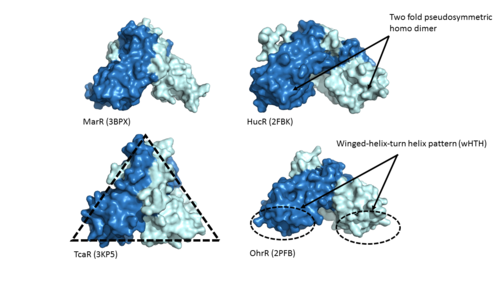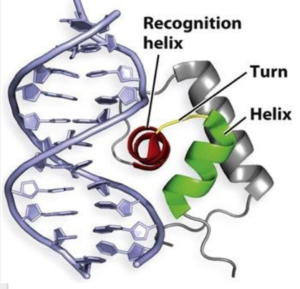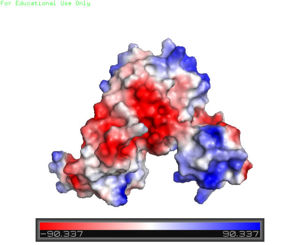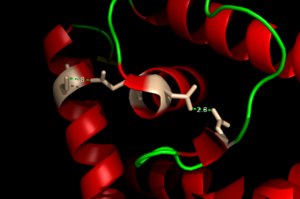Sandbox Reserved 1063
From Proteopedia
(Difference between revisions)
| Line 10: | Line 10: | ||
==='''Structural Overview'''=== | ==='''Structural Overview'''=== | ||
| - | One of the two functional domains of AdcR is <scene name='69/694230/Dimerization_domain/3'> dimerization domain</scene>. This domain connects and stabilizes the two pseudosymmetric dimers and is composed of the <scene name='69/694230/Alpha_1/1'>α1 helix</scene>, the C-terminus of the <scene name='69/694230/Alpha_five/1'>α5 helix</scene> , and the <scene name='69/694230/Alpha_6/1'>α6 helix</scene>. This domain is connected to the DNA binding domain by the long α5 helix. The DNA binding domain stabilizes the major and minor groove of DNA via the <scene name='69/694230/Whth_4/ | + | One of the two functional domains of AdcR is <scene name='69/694230/Dimerization_domain/3'> dimerization domain</scene>. This domain connects and stabilizes the two pseudosymmetric dimers and is composed of the <scene name='69/694230/Alpha_1/1'>α1 helix</scene>, the C-terminus of the <scene name='69/694230/Alpha_five/1'>α5 helix</scene> , and the <scene name='69/694230/Alpha_6/1'>α6 helix</scene>. This domain is connected to the DNA binding domain by the long α5 helix. The DNA binding domain stabilizes the major and minor groove of DNA via the <scene name='69/694230/Whth_4/7'>winged helix-turn-helix (wHTH)</scene> motif. Binding of Zinc allows AdcR to bind DNA and activate the transcription of high-affinity Zinc specific uptake transporters. The binding of Zinc to the <scene name='69/694230/2_binding_sites/4'>Zinc binding pocket</scene> induces a conformational change that allows for a hydrogen bond network between helices of the binding domain. It is believed that this hydrogen bond network is the allosteric activator needed to expose residues that bind the bases along the major groove of the DNA <ref name="guerra">PMID:22085181</ref>. The binding sites are found adjacent to the DNA binding domain. |
| Line 16: | Line 16: | ||
=== Helix-Turn-Helix Motif === | === Helix-Turn-Helix Motif === | ||
[[Image:Screen Shot 2017-04-18 at 11.56.32 PM.png|300 px|right|thumb|'''Figure 1'''. A generic protein representing the wHTH motif binding the major and minor groove of DNA similar to AdcR.]] | [[Image:Screen Shot 2017-04-18 at 11.56.32 PM.png|300 px|right|thumb|'''Figure 1'''. A generic protein representing the wHTH motif binding the major and minor groove of DNA similar to AdcR.]] | ||
| - | The AdcR MarR transcriptional regulator's structure resembles the other proteins in the same family as mentioned before; however, the most notable differences are found in the winged helix-turn-helix (wHTH) motif that assists in binding DNA. The <scene name='69/694230/Whth_4/ | + | The AdcR MarR transcriptional regulator's structure resembles the other proteins in the same family as mentioned before; however, the most notable differences are found in the winged helix-turn-helix (wHTH) motif that assists in binding DNA. The <scene name='69/694230/Whth_4/7'>winged helix turn helix</scene> motif is made up of the <font color='blue'>alpha 3</font> and <font color='blue'>alpha 4 helices</font> along with <scene name='69/694230/Anti-parallel_beta_sheet/2'>anti-parallel beta sheets</scene> on each side. There is one wHTH motif per monomer. The recognition helix, or the alpha 4 helix, binds the major groove of DNA through hydrogen bonding and Van der Waals interactions between exposed bases. The wings of the helix bind the minor groove of DNA while the other helices stabilize the DNA and Protein upon binding. The two anti parallel beta sheets contain several <scene name='69/694230/Positive_residues_on_wing_3/3'>Arginine, Asparagine, and Lysine residues</scene> that stabilize this interaction between DNA. The charge map down below highlights the dark blue tips consisting of lysine and arginine residues, which stabilize the negatively charged backbone of DNA. |
Revision as of 18:35, 21 April 2017
Adhesin Competence Regulator
| |||||||||||
References
- ↑ Sanson M, Makthal N, Flores AR, Olsen RJ, Musser JM, Kumaraswami M. Adhesin competence repressor (AdcR) from Streptococcus pyogenes controls adaptive responses to zinc limitation and contributes to virulence. Nucleic Acids Res. 2015 Jan;43(1):418-32. doi: 10.1093/nar/gku1304. Epub 2014 Dec, 15. PMID:25510500 doi:http://dx.doi.org/10.1093/nar/gku1304
- ↑ Ma Z, Jacobsen FE, Giedroc DP. Coordination chemistry of bacterial metal transport and sensing. Chem Rev. 2009 Oct;109(10):4644-81. doi: 10.1021/cr900077w. PMID:19788177 doi:http://dx.doi.org/10.1021/cr900077w
- ↑ 3.0 3.1 3.2 3.3 Guerra AJ, Dann CE, Giedroc DP. Crystal Structure of the Zinc-Dependent MarR Family Transcriptional Regulator AdcR in the Zn(II)-Bound State. J Am Chem Soc. 2011 Nov 21. PMID:22085181 doi:10.1021/ja2080532
- ↑ 4.0 4.1 Reyes-Caballero H, Guerra AJ, Jacobsen FE, Kazmierczak KM, Cowart D, Koppolu UM, Scott RA, Winkler ME, Giedroc DP. The metalloregulatory zinc site in Streptococcus pneumoniae AdcR, a zinc-activated MarR family repressor. J Mol Biol. 2010 Oct 22;403(2):197-216. doi: 10.1016/j.jmb.2010.08.030. Epub 2010, Sep 8. PMID:20804771 doi:http://dx.doi.org/10.1016/j.jmb.2010.08.030




